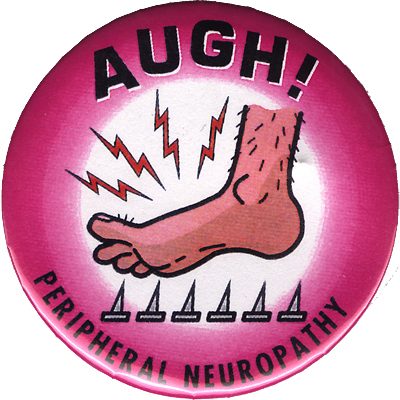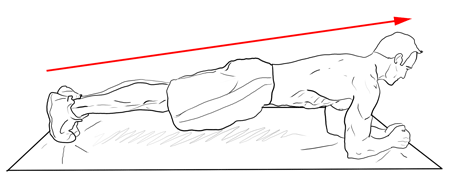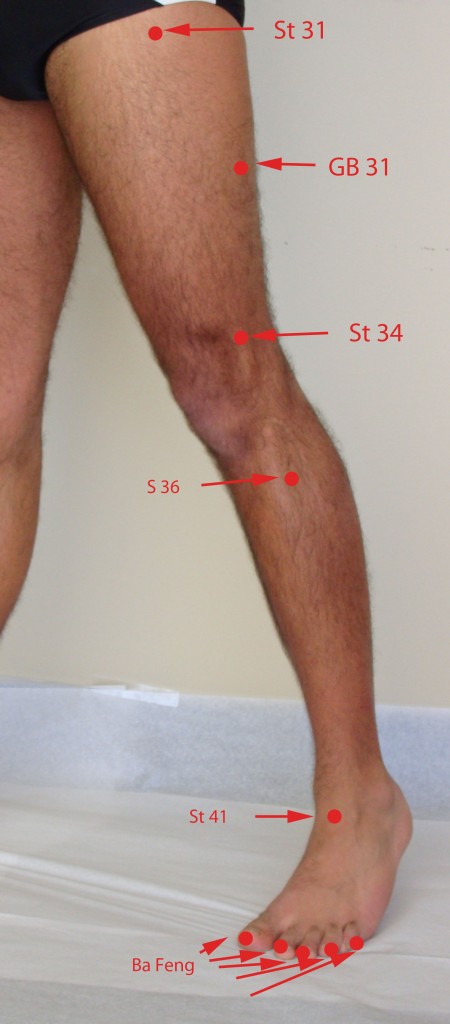News Letter, Vol. 5 (6), July, 2013, © Copyright
Jun Xu, M.D. Lic. Acup., Hong Su, C.M.D., Lic. Acup.
Robert Blizzard III, DPT
www.drxuacupuncture.co
Rehabilitation Medicine and Acupuncture Center
1171 East Putnam Avenue, Building 1, 2nd Floor
Greenwich, CT 06878
Tel: (203) 637-7720, Fax: (203)637-2693
Peripheral Polyneuropathy
Fig 1 http://www.nlm.nih.gov/exhibition/aidsephemera/button1.html
Joanna, a 46 year-old female, has been feeling numbness into her feet for the past month. She felt uncomfortable to drive and walk because of decreased sensation at both feet. She has been losing her balance as sensation is decreasing in her feet. She never had any of these issues before, always having great balance, as she was a gymnast when she was younger but since her collegiate gymnastic career ended she has not been as active and slowly has been gaining weight. She was diagnosed with diabetes about 20 years ago and continues to use insulin. Joanna had a few mild falls because she started to lose feeling at her both feet. Her husband found her right foot bleeding, however, Joanna reports never feeling that she stepped on anything. Joanna went to her physician who examined her and she was found to have decreased sensation at both hands and feet with glove and stock distribution. Both her feet showed a little black color with lost hair and dry skin. She then was referred to me for eval and treatment. I performed Nerve Conduction Velocity and Electromyography Tests, which conformed Joanna had peripheral neuropathy.
Peripheral neuropathy is damage to the nerves outside of the central nervous system. The peripheral nervous systems transmit messages to and from the extremities to the spinal cord and brain. Damage to the sensory nerves would result in slowed or lost relay of information on touch, pain, temperature, position and vibration. If the motor aspect were damaged then muscle contraction or muscle tone would be impacted, even the supplied muscle would be atrophy. Autonomic nerve damage would decrease the ability of vital organs or process that control blood pressure, sweating, heart rate to list a few.
The most common peripheral neuropathy is diabetic; as in the United States between 60-70% of diabetics have some form of damage to the nervous system. It is the result of poorly controlled blood sugar levels. Though less common, diabetes can also cause mononeuropathy, often characterized by weakness of the eye or of the thigh muscles. Peripheral neuropathy can be inherited caused by genetic code mutations, with Charcot-Marie-Tooth disease being the most common inherited peripheral neuropathy. Other identified causes include traumatic injuries, infections, alcohol abuse, external pressure on nerves, nutritional deficiency, metabolic problems or toxin exposure.
These are the most common symptoms of peripheral polyneuropathy:
Tingling
Numbness
Loss of sensation in the hands and feet
Burning, pins and needles sensation
Because people with chronic polyneuropathy often lose their ability to sense temperature and pain, they can burn themselves and develop open sores as the result of injury or prolonged pressure. If the nerves serving the organs are involved, diarrhea or constipation may result, as well as loss of bowel or bladder control. Sexual dysfunction and abnormally low blood pressure also can occur.
Joints are particularly vulnerable to stress in people with polyneuropathy because they are often insensitive to pain.
One of the most serious polyneuropathies is Guillain-Barre syndrome, a rare disease that strikes suddenly when the body’s immune system attacks nerves in the body. Symptoms tend to appear quickly and worsen rapidly, sometimes leading to paralysis. Early symptoms include weakness, tingling, and loss of sensation in the legs that eventually spreads to the arms. Blood pressure problems, heart rhythm problems, and breathing difficulty may occur in critical cases. However, despite the severity of the disease, recovery rates are good when patients receive treatment early.
Current tests for peripheral neuropathy include:
Blood Tests: will determine if levels are out of norms for vitamins, blood sugar or if organs are not operating properly
Imaging Tests: will rule out other issues such as herniations, tumors or possible other explanation of symptoms
Nerve Function Test: Nerve Conduction Velocity (NCV) and Electromyography (EMG) tests will differentiate between muscle and nerve disorders
Nerve Biopsy: will determine what is damaging the nerve, though is often not necessary for diagnosis
As with many conditions, ensuring a healthy lifestyle will be beneficial. Eating a balanced diet, maintaining a healthy weight, daily-supervised exercise regime are the staples. Lifestyle changes that are crucial to modify include excessive alcohol consumption and quitting smoking as blood vessels are constricted and will limit nutrient delivery to the peripheral nerves impeding recover. Diabetics need to ensure proper self-care of their feet as sensations are dampened to begin with and need daily inspection to examine for any wounds.
Systemic disease will be more complicated to treat, as strict control is needed. For diabetics, if blood glucose levels are not maintained then continued nerve damage is likely to occur. Autoimmune and inflammatory conditions can lead to neuropathy that can be controlled with prednisone, an immunosuppressive drug. Inflammation can also be limited with procedures such as plasmapheresis, in which the blood is removed from the body, cleansed in a lab then injected back into the body. This process limits inflammation helping to suppress abnormal immune system activity.
Physical Therapy
A physical therapist can help in selecting mechanical aids that will reduce pain, improve function and decrease physical impairments. A wrist brace can compensate for muscle weakness or alleviate compression on a nerve. Proper orthopedic shoe selection can greatly improve walking performance by limiting risk of foot injuries and enhancing balance.
Depending upon the root of the neuropathy and the symptoms present, the physical therapy protocol varies significantly. Improving balance and strengthening muscles around the ankle and core are often very useful. This exercise should be started on a flat surface (not shown) then progressed to a foam pad. Steady balance needs to be mastered before attempting to reach forward with the feet or hands. Try 5 reps each direction of 12– 3– 6 and 9 O’clock repeated on both legs for 5 total sets.
Fig 2 www.optp.com
A movement such as the front plank is a terrific core exercise that will improve posture during the day. Patients are encouraged to keep a straight or neutral body alignment from their ear down through their ankles while holding this position. Set a timer for 2 minutes, holding as timer is running and when a break is needed hitting pause on the timer until 2 minutes of holding the plank is up.
Fig 3 http://www.fitnessforhumans.com/2011/05/19/abdominal-planks-for-core-strength/
Surgical intervention if needed can provide immediate relief when symptoms are caused by compression or entrapment injuries. Such surgery would be to repair a herniated disc relieving pressure on the nerve. Other examples or surgery would be if a tumor was impinging a nerve or if the nerve entrapment is a result or constricting ligaments or tendons.
Acupuncture Treatment
Acupuncture may not control the blood sugar and/or treat the cause of peripheral polyneuropathy. However, acupuncture is a very good tool to alleviate the symptom of tingling, numbness, loss of sensation in the hands and feet and burning, pins and needles sensation.
Peripheral Nerve- numbness, tingling, ants climbing, glove and stock distribution, cold extremities, foot drop, decreased knee and ankle reflex, no sweating, sometimes, feels weakness and muscle atrophy.
The treatment should focus on both upper and lower extremities. The points selected are
- Upper extremity: LI 15 Jian Yu, LI 11Qu Chi, SJ 5 Wai Guan, LI 4 He Gu, SI 4 Wan Gu, SJ 4 Yang Chi, and extra points Ba Xie,
- Lower Extremity: St 31 Bi Guan, St 34 Liang Qiu, GB 31 Feng Shi, St 36 Zu San Li, St 41 Jie Xi, and extra points Ba Feng.
Many patients may have depression and low energy, therefore, the points on the Brain are very important, I usually choose: Du 21Bai Hui, Si Sheng Chong, GB 8 Shuai Gu, Tai Yang, Du 23 Shang Xing, Ying Tang, etc.
For Coldness at feet and hands, I also choose Ren 4 Guan Yuan, Ren 6 Qi Hai, UB 20 Pi Shu, UB 23 Shen Shu.
For poor balance and unsteady gait: SI 19 Ting Gong, GB 2 Ting Hui, GB 20 Feng Chi, Ren 16 Feng Fu, Du 21 Bai Hui, Si Sheng Chong
For GI symptom, such as: bloating, abdominal pain, diarrhea and constipation, St 36 Zu San Li, St 37 Shang Ju Xu, St 39 Xia Ju Xu, Ren 12 Zhong Wan, PC 6 Nei Guan, UB 21 Wei Shu and UB 20 Pi Shu.
Fig 4
Fig 5
Fig 6
fig 7
Fig 8
The treatment course of Joanna:
Joanna underwent my treatment 3 x per week for 4 weeks, she first felt less burning pain, and a steadier gait, but she still felt numbness and tingling sensation in both feet. After two weeks of treatment she started to feel warmth in both feet, she could sleep better. After finishing 4 weeks of treatment she walked much better, and she drove smooth and steady. She then continued her maintenance program once a week for 8 weeks, she is much more comfortable to walk and drive now. Her sensation in both feet was much better, she no longer had a burning sensation, but she still felt mild numbness. She was told to strictly control her blood sugar and gradually her numbness and tingling sensation disappeared.
Tips for patients:
- The most important treatment is control of blood sugar.
- You should always wear white socks, if you have any wound in your feet, you will find it right away by checking your socks.
- Clean and check your feet with mirror every day, you will find the wound and take care of it right away.
- Keep balance training, you will keep your balance much better with the progress of peripheral Polyneuropathy.
- Massage your feet as following, 15 min 3 x per day, which will greatly help your symptom.
Fig 9 www. overstock.com
Tips for Acupuncturists:
- Always use electrical stimulation.
- Using plum – blossom needle to tap the feet around the plantar feet may also receive good result.
- Always teach patients to check their wound in the feet and hands.









